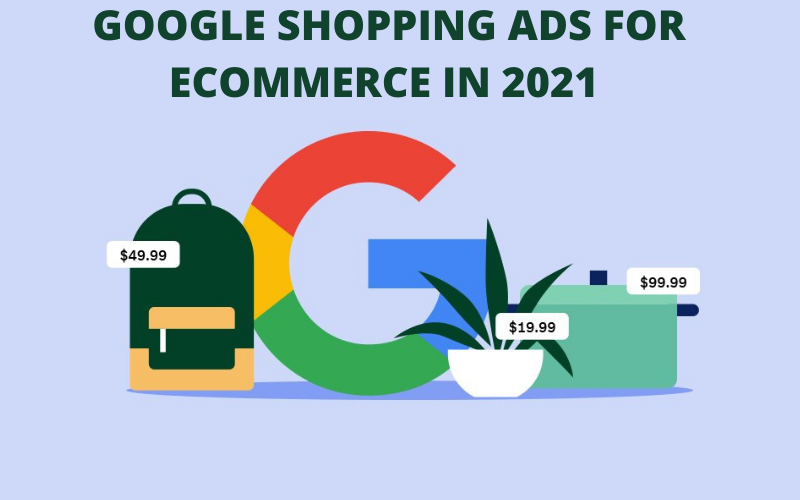Google has come up with exciting tools that have enabled businesses to try their hand at digital marketing. Unlike the times when marketing was only through expensive advertisements on traditional platforms, we have the option to expand our presence on different media platforms.
As we know the shopping campaign generates more than 70% of revenue for the E-Commerce store. Today we are going to share some full proof of great and effective ways to boost the performance of shopping campaigns.
Let us divide the whole guide into sections. This will simplify the guide and let you understand it in a much better way.
Here is the Step By Step Guide For Google Shopping Campaign
- What is a shopping ad? How to set up a Shopping campaign?
- How to Optimize shopping campaigns?
- Tips to scaling the shopping campaign profitably.
1. What is a Shopping Ad Campaign?
Even if you are still a beginner at learning the technical aspect of shopping ads, this guide will fasten your process to becoming an expert. Google Shopping is a comparison shopping engine, which is a service that permits retailers to advertise their products to searchers in a visually appealing way.
This means if someone searches for a product that you sell, Google will show relevant Shopping ads for your products, and those of your competitors.
If the user clicks on your ad, Google will take her right to the merchandise page.
Each Google Shopping ad includes a picture, the merchandise title, the price, the name of the retailer, and sometimes some retailer-specific information like shipping costs or reviews.
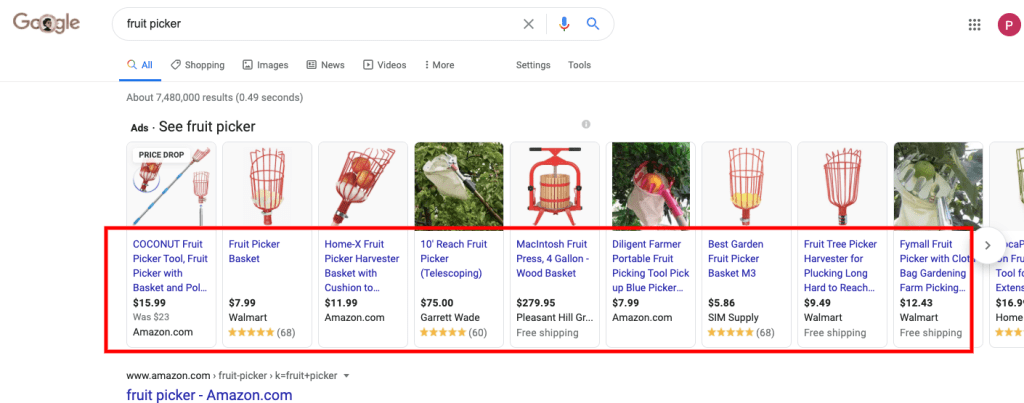
Google Shopping can be run in more than 40 countries. It’s not the sole comparison shopping engine, but far and away from the foremost popular one.
Types of Google Shopping Campaigns
There are 2 types of Google shopping campaigns we get to choose from in Google ads:
- Standard Shopping Campaigns
- Smart Shopping Campaigns
How To Setup a Standard Google Shopping Campaign?
Now, you will know how to set up a shopping campaign. We will tell you stepwise so that you will be able to understand easily.
Step 1: Click on the plus sign.

Step 2: Select [Sale] as a goal.
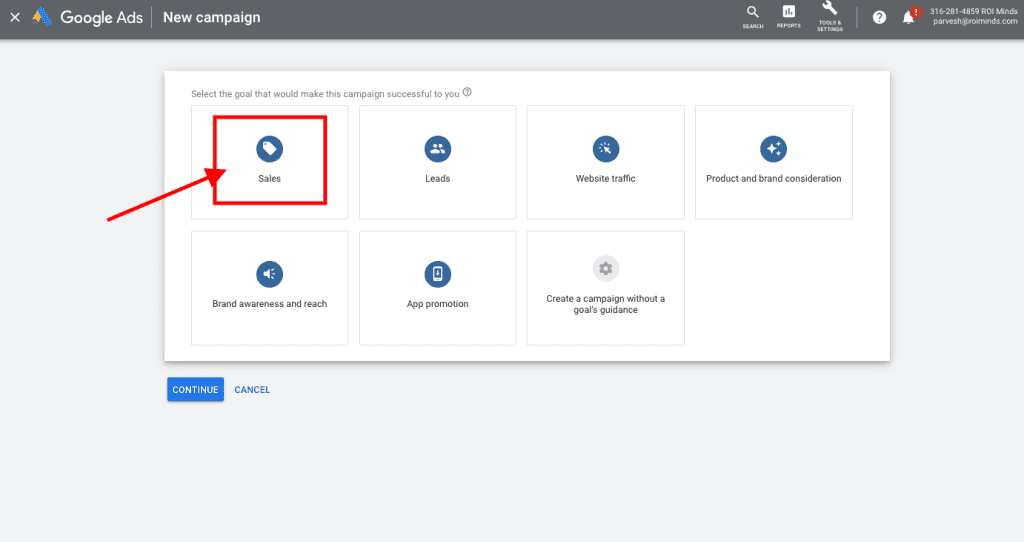
Step 3: Select Shopping as a campaign type.
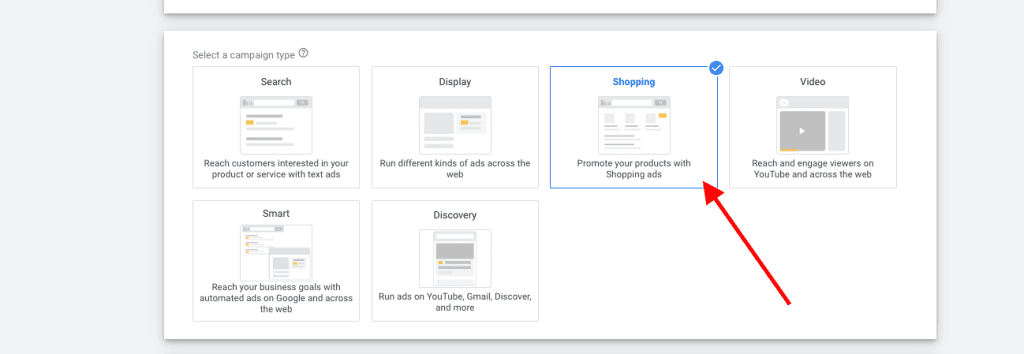
Step 4: Select Standard shopping campaign option.

Step 5: Write the Campaign name and select the bidding option.

Step 6: Select the network on which you want to run ads.

Step 7: Select the location on which you want to run ads and click on save and continue.

What is Google Shopping?
Here is a unique tool to make your ads smart and effective. Smart Shopping is one of the relatively new features in Google’s portfolio. It uses Google’s AI technology to optimize the Google Shopping campaign and maximize conversions and ROAS.
With Smart Shopping two things, a user has to choose are the target of the campaign and give a budget. The rest of the process is taken care of by AI. And what does AI do?
Smart Shopping automatically bids for us and displays the ads in several Google networks, which include Google Search Network, Display Network, YouTube, and Gmail. It also covers various types of ads like display ads, local inventory ads, and product shopping ads.
How Does Shopping Work?
Also to regular Google Shopping Ads, a user must have access to Google Ads and Google Merchant Center accounts, load product feed data to Merchant Center account, select the country, and choose a budget. There’s a further choice to choose the bidding strategy.
What’s different from regular Shopping Ads, is the automation. Google uses the provided information to make a decision on what proportion to bid, also as where and when to display the ads. It happens because of its machine learning tools.
The goal is to realize the simplest possible conversion rate while reaching the chosen target. Google tries to accumulate as many potential customers as possible. It aims to seek out the audience that’s wanting to spend more.
Google Smart Shopping vs. Google Shopping Ads
These are the main differences between Google Smart shopping and Google shopping ads. It will help you to decide if you can go with Google Smart shopping or not.
| Google Smart Shopping | Google Standard Shopping |
| Quick and highly automated | Full control over the campaign |
| Easy to set up | Manual and complex |
| Saves a lot of time | Very time-consuming |
| Limited device and location targeting | Full device and location targeting control |
| A broad range of ad types | Demands experience knowledge |
| Exposure in many networks | Possibility to choose networks |
| No possibility to use negative keywords | Possibility to use negative keywords |
| No Bid adjustments | Bid adjustments |
| No granular data analytics | Granular data analytics |
How to Set up Google Smart Shopping?
Before activating Smart Shopping, confirm to suit Google’s requirements with regard to the present tool. The foremost important ones say that you simply got to set up conversion tracking and add a global site tag to your website. aside from that, the standard conditions and policies for Google Shopping must be met.
- Once you do the above, create a brand new campaign in Google Ads.
- Select the goal if you wish to (Sales, Leads, Website traffic, etc. )
- Choose smart Shopping as a Campaign type
- You have to select a smart shopping campaign
- Insert the budget value
- You’ll also choose the Smart bidding target
- Perform the standard steps, like adding the name, uploading the merchandise feed, and selecting a country.
- Click Save and it’s ready.
Remember that the Google Smart Shopping campaign features a priority over a standard Google Shopping campaign.
So if you are also running the standard shopping campaigns with smart shopping campaigns, Google will give the priority to smart shopping campaigns to display the ads.
So it is advisable to pause the standard shopping campaigns when using smart shopping campaigns.
2. How to Optimize the Smart Shopping Campaign?
Now, we are sharing 100% accurate and resulting tips to optimize shopping campaigns. You can use these strategies to make the shopping campaigns effective, affordable, and target oriented.
5 Steps to Optimize Google Smart Shopping Campaigns
A) By using Proper Custom Labeling –
Custom labeling is a type of tag that you can use to filter and group the products in Google Ads campaigns.
Before we understand how to use custom labeling in google shopping, you have to be clear about why you need to use custom labeling.
Why do you need custom labeling?
- Grouping specific category products together.
- Better overview of your performance campaigns.
- Finding the sweet spots products.
- Better control over the campaigns.
- You can higher bid on fast-selling products and lower the bid on slow-selling products.
- You can apply custom labels according to the group and set different bids based on different product groupings in the ads campaigns.
Custom labeling is an easy way to organize your products. Custom labels have 5 empty boxes where you can add your data or value according to your requirements. Custom labeling starts from 0 and ends with 4.
Easy ways to use custom labeling
Based on seasonality – spring, summer, and winter seasons.
based on profit margin – Long sleeve shirts and jeans have a high-margin products.
Basis of high-performing products – leather shoes (high-selling products).
Or
You can use custom labeling according to the product category like – Socks, Shoes, jeans, Shirts, etc.
Custom labeling is a simple and quick way to organize your shopping campaign. Below are some cases where you can use custom labels accordingly:
Case 1
You can label your products based on the high, medium, and low-profit margins and adjust bids accordingly on it.
Like you can use custom label 0- profit margin according to low, medium, and high-profit margin items.
Case 2
You can adjust the bids based on product pricing. Also, you can assign higher bids on the most expensive items and lower the bids on less expensive items.
You can use custom label 1 -price categories like under $25, under $40, and under $70.
Case 3
You can show your products based on seasonality base. Show the right products based on the season. Like shows woolen clothes in winter.
Here you can use Custom Label 2- seasonal base according to Spring, summer, and winter.
Case 4
Sales items and free shipping
You can use a custom label based on a free shipping product and have to find which products are most interested in and then custom label those items.
Here, you have more chances to convert on those items.
You can use Custom label- 3 shipping or free shipping.
You can use all custom labels at once if you want.
For example –
First, you analyze your product data. After analyzing you find out that your highest performing item is short sleeves men’s category under the range of $30 to $50 plan shirts. Now you can custom label these categories.
- Custom Label 0 – Men’s Tee
- Custom Label 1 – Short Sleeve Shirt
- Custom Label 2 – Summer
- Custom Label 3 – under $30 to $50
- Custom Label 4 – Plain Shirt
Now you have to set up a campaign based on these custom labeling. Because you know that this category item is performing very well.
Now, you have to set up a simple shopping campaign and only run these custom-labeling category items and exclude all products.
Google gives you the option to filter the product based on a brand name, product type, google product category, condition value, etc.
After assigning all custom labeling you can use the custom label in your shopping campaigns.
You can use the custom labels in Google Shopping in two ways. The first way, you click on campaigns then go to the settings tab and click on the inventory section where you can use custom labels according to your requirements.
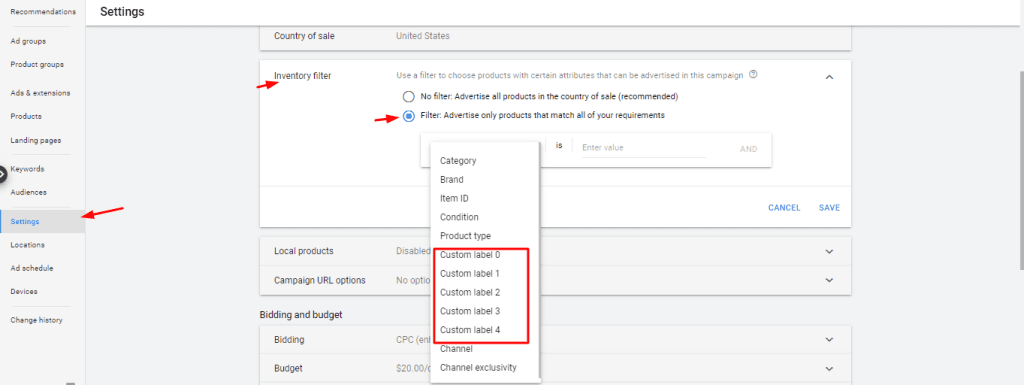
The second option is to click on the campaign and then click on specific ad groups, now click on the plus button in front of all product tabs. Here you can select your custom labels according to your need.
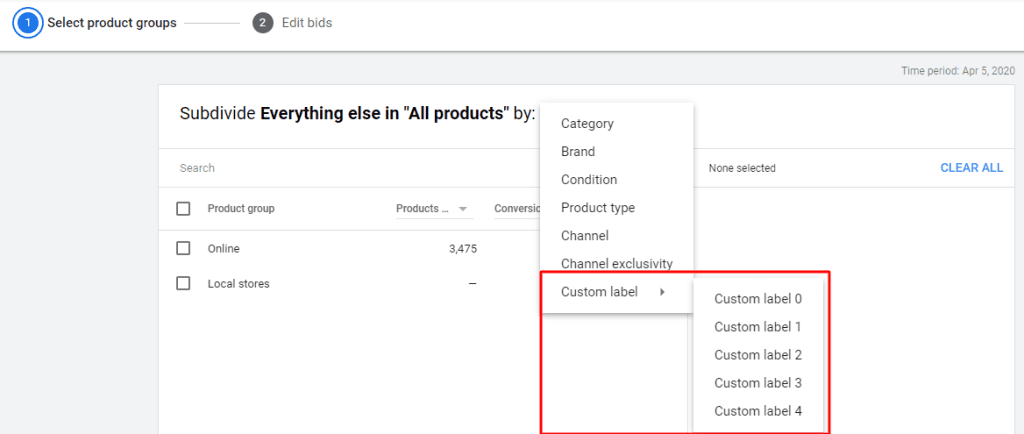
B) By Finding Negative Keywords –
As we know, for search ads campaign and shopping ads campaign 90% success depends upon how many keywords we will put in negative keywords.
Have you asked yourself why we find negative keywords? If not, that is very important to know about this question before finding negative keywords.
What are negative keywords? Why do we find negative keywords?
Search terms that are not relevant to our ads, landing page, and service that we are offering. These search terms we can call negative keywords.
It is important to find negative keywords because by finding negative keywords, we closed the door to the irrelevant search term. So, due to this more and more relevant search terms will come that increase the chance for conversion.
So, hope you understand why we find negative keywords. The negative keywords work well and help to make the entire marketing strategy a success.
Best Ways To Finding Negative Keywords
Now, the next question arises “ How can we find the right negative keywords?
Here, we share our 3 best steps to find negative keywords that help us in boosting the performance of the client’s project.
Step – 1 First Step ( Understand your product properly)
Firstly understand your product properly; as it is important to understand your productivity to find the right negative keywords.
The main question is “What things you should consider while understanding the product, find as below:
a. Product category
b. Product qualities
c. Product usage
d. Who can buy that product?
Below you can see the product image, detail, specification, etc.
The point that has to note:-
a.) Product used to move heavy furniture
b.) furniture lifter and roller
c.) Pad slider
d.) Made of plastic and have a PVC handle
e.) Price $49.9
f.) Discount 50% off

Step-2 (Understand keyword search terms)
After a proper understanding of the product, you have to understand search terms.
Put the search term into a negative keyword list that is not relevant to the above-noted points of the product.

Above image is showing negative keywords:-
-lifting dolly
-safe mover dolly
-machinery dolly
-Lifting heavy aquarium
Find this type of negative keywords from the search term and then put them into a negative keyword list.
Step – 3 (competitive analysis)
There are many search terms that are relevant but unable to be converted into leads.
So, this type of search term is also important to put in a negative keyword list.
For example:- One search term we found was “ heavy furniture lifter “which takes $36 cost with zero conversion. Then we searched that term on Google and found that the same product is dealing with low prices here and also some companies offer free shipping here.
So, on this search term, we will not get any conversion until we set the lowest price and give any other offer. So, put this search term into a negative keyword

By conducting these three steps you will find 100% negative keywords. That will automatically boost your campaign performance by coming from the relevant customer.
Hope, you will know “ how to find negative keywords ? “ in an efficient manner.
C) By Extracting Out Non-Performing Products.
Firstly set up a shopping campaign with proper custom labeling on the basis of profit margin, category & on the basis of product price.
After that, you will see that there are some products that are not running well. In this case you can optimize your campaign by pausing nonperforming products from existing campaigns & create a new campaign to run this product.
“ Note that – you have to set up one ad group for one product”
After creating a single product ad group now you can easily optimize the search term by finding negative keywords. So that irrelevant clicks are skipped and only relevant clicks are counted that increases the chance of getting converted.
D) By changing Bid Strategy
There are many bid strategy with the help of these you can optimize your campaign –
- Target CPA –Target CPA bidding is a bidding strategy you can use if you want to optimize conversions. With this method, Google Ads will automatically set your bids on each campaign based on your CPA. While some conversions may cost more, others may cost less to even out and align with your acquisition costs.
- Target ROAS –Target ROAS is the bidding strategy where Google Ads will set your bids to maximize conversion value based on the return you want from your ad spend.
- Maximise Conversion –Using the maximum daily budget that you set, Google will automatically run your bidding for you to get you the most conversions for your money.
- Enhanced Cost Per Click –Google has the right to increase or decrease your bid amount based on the likelihood of driving the sale.
- Maximise Clicks –Google Ads will attempt to drive the most clicks possible with your daily budget.
- Manual CPC – Manual CPC is where you set bids for different ad groups or placements on your own. If specific campaigns are more profitable than others, you can quickly adjust budgets to add money or remove them from other campaigns.
E) Product Title and Description Optimization
Since you can’t target keywords directly, include them in the product titles & descriptions to get most people clicking on your product you need to do complete keyword research first before proceeding.
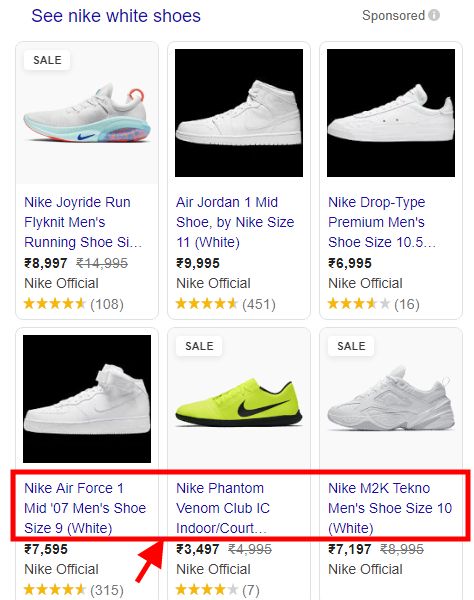
14 CASE STUDY OF Smart SHOPPING CAMPAIGN
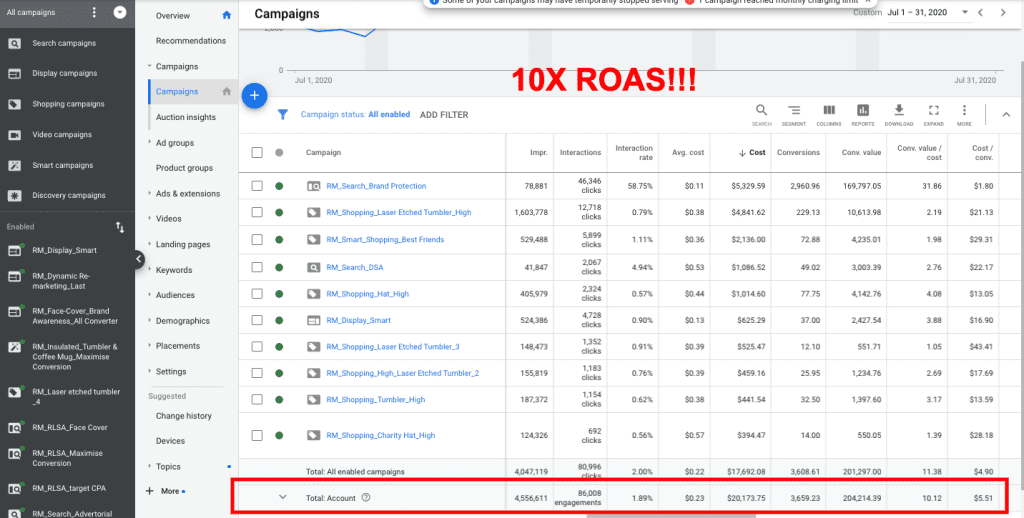
Here, you are seeing the screenshot of the Google ads account. We are giving our client 10x ROAS from the shopping campaign.
We at ROI Minds have implemented a winning formula that works and magnifies the results. Here are our plans and strategies made by ROI Minds to increase the ROI of your Google Shopping campaigns:
1. Make sure campaigns are segregated properly based on product value, margins, and promotions.
Before creating a campaign, you need to know what you’re trying to accomplish. This includes sketching your goals and preparing what you’ll need to carry out your campaign, like a landing page, an AdWords budget, and more.
The first goal you need to set for your new campaign is what progress and success look like. It could be anything from assigning an order to access their email address to join your email list.
If you have infinite goals, then you must write them all down. Every ad group should focus on only one goal. When you have many goals, you need multiple ad groups in your campaign.
2. Make campaigns and product groups as granular as possible to simplify the bidding and testing process for the budget and impression share.
The bidding procedure you choose depends on your initial campaign goal. If your aim is to make more trades and sales for your E-commerce store, “Maximize Conversions” is the way to perform. AdWords will show your ads to people more inclined to buy, based on factual data.
If your aim is to drive traffic to your site, you want to maximize for clicks alternatively. This will optimize your campaign for the tremendous number of clicks, rather than focus on whether users regenerate or not.
Set Your Budget
You wouldn’t originate any other marketing initiative without a budget in mind. Possessing a particular number in mind is crucial before you even log in to AdWords.
Without one, you’ll bankrupt your budget in no time. AdWords works on a regular budget basis. To discover the daily budget to use for your campaign, figure out your entire monthly ad spend budget, then divide that by 30.
Make sure this is a practical budget to achieve your goals. Having a $100 monthly budget with a goal of making 50 sales of a $10,000 product isn’t going to skip it.
3. Utilize the promotion feed from the Google merchant account to get an additional competitive advantage.
The online shopping space is more boisterous than ever and you would clearly be questioning how you can make your ads stand out so people visit your landing page instead of your competitor’s one.
Google Shopping gives a solution for you to show your promotions within your Product Listing Ads, so they will really stand out from contenders. Merchant Promotions are designated in shopping ads with footnotes that trigger a pop-up with supplementary details and a “Shop” button. They proved to significantly enhance CTR and ultimately Conversion Rate, Revenue, and ROI.
Google Merchant Promotions also allows you to determine your discount to a comprehensive audience at no added cost, securing the best ad placement you would ever think of at the very top of the Google Search Result Page.
In fact, unlike regular search ads, Shopping Ads regularly appear at the top of the SERP (Search Engine Result Page) and are one of the most noticeable elements on the page.
4. Identify top-performing products and set up them in the individual campaigns with a dedicated budget and high-priority settings to acquire at least 60% search Impression share
Many times instances have been seen where clients pause keywords because they aren’t creating click or impression volume. While pausing is unquestionably one method for acting on low-performing keywords, we typically recommend pausing only as a last option.
There is everything to consider when it comes to diagnosing why a keyword isn’t generating volume, and one often overlooked, yet illuminating metric is
Impression share
Impression share is the number of impressions you have received divided by the predicted number of impressions you were eligible to receive. Worth is based on your current ads’ targeting settings, endorsement statuses, bids, and Quality Scores. You can survey, and impression share data at the campaign, ad group, and keyword levels.
5. Use Product Ratings, Seller ratings
Have you ever inquired how to get the stars on your Google Adwords ads? A desire to efficiently boost conversions and beat your contestants? Google has now made it a lot more manageable to get the stars.
Before you had to do all kinds of assimilation into your Google Base or Google merchant account, but not anymore. Now what Google does is license out to 32 autonomous 3rd party review companies.
These companies are allowed by Google and the stars are normally the ones that you see in Adwords CPC TEXT ads or your Google Shopping ads (PLAs).
Not solely will the star ratings show in your Google Adwords, but they will show in Bing Ads/Yahoo BTW, BingAds controls Yahoo PPC. These merchant rating stars will work for both service-based companies and eCommerce websites.
6. Make sure to use custom labels on every possible product for the segmentation
With Shopping campaigns, you can use design labels when you want to divide the products in your campaign using the values of your selection. For example, you can use custom labels to indicate that products are periodical, on clearance, best sellers, etc. These values can then be elected to use for monitoring, reporting, and bidding in your Shopping campaign.
Campaign precedence is also beneficial when you’re advertising the same product, for the same country, in various Shopping campaigns. To use the campaign priority setting, you first need to generate a Shopping campaign.
But always remember that campaign priority is only necessary if you have multiple Shopping campaigns that promote the same product. Campaign priority is not agreeable with Showcase Shopping ads.
7. Make product groups based on the themes and profits
AdWords keyword grouping is a surveyed part of the AdWords workflow. Not everyone understands that creating parsimonious, better-organized ad groups in your AdWords account can have a big positive effect on your overall report performance.
That’s because well-organized keyword accumulations improve your account’s significance, which raises your Essence Score and lowers your cost per click.
Dramatically grouping and classifying your keywords to improve your PPC strategies by enabling you to create:
- More Quality–Score-friendly ad groups
- More relevant text ads
- More effective landing pages that drive more conversions
- While you segment your keywords, PPC campaigns are more prosperous and cost-effective from end to end.
8. Use Google Merchant automatic rules to avoid unnecessary product disapproval
After your promotion feed and commodities feed are concocted, Google evaluates and validates your promotions before administering them. This process is typically finished within 12 hours but can take up to 24 hours.
We at ROI Minds suggest you avoid unnecessary product disapprovals and submit your promotions as early as possible for a timely review.
The approval process requires 2 steps:
1. Custom review: The custom review strengthens the progression following all editorial obligations and program strategies and will occur quickly after a promotion is tendered during workday business hours.
2. Validation review: When a promotion becomes engaged on your site, Google testers will confirm that the promotion works and that it follows all program policies.
9. Manual ECPC and gradually set to CPA bidding strategy by starting campaigns
Enhanced cost-per-click (ECPC) aids you to get more progress from manual bidding. ECPC runs by automatically adjusting your manual bids for clicks that resemble more or less likely to lead to a sale or exchange on your website.
Unlike Target CPA, which automatically sets bids based on your destination cost-per-conversion, ECPC is restrained by your max CPC bids when optimizing for conversions.
For exploration and exposure campaigns, ECPC benefits in increasing conversions while attempting to keep your cost-per-conversion identical to what you are receiving with manual bidding. For Shopping, ECPC helps in increasing conversions while striving to maintain your same overall spending.
If you want to use Enhanced CPC with Search or Shopping campaigns, you’ll need to set up conversion tracking also you don’t need conversion tracking to use ECPC with display campaigns, but conversions will help you see whether your ads are capable and effective or not.
10. Ensure to identify as much as possible from everything else in the product group.
Creating your account enables you to entirely serve the right ads to the right customers, and it also enables you to thoroughly track the effectiveness of your advertising efforts.
When people are scrutinizing online and they type a word or phrase, they are probably looking for information that’s intimately tied to those words. For example, if Varun types a digital watch and he sees an ad for film reels, he will probably not click the ad.
To show ads that are appropriate and applicable to the searches of people you are trying to reach, bundle and gather your related ads together with related keywords into an ad group. By using this way, all of your related ads would be displayed to customers searching for related things.
11. Keep updating your negative keywords list.
If there are some kind of search terms that give you undesired impressions or clicks across various campaigns, you can create a negative keyword list that includes those terms, then apply the list to appropriate campaigns.
This way you won’t have to manually add the related negative keywords to a particular campaign, and you can more efficiently manage future changes to negative keywords across campaigns.
To build and update a negative keyword list, you would have to think of concepts and words that you don’t want triggering your ads. You can use the search terms outline to get ideas.
You may also want to prepare these words by themes, such as the different products or services you offer. You can also add up more than 4000 negative keywords per list, and create more than 15 negative keyword lists in your account.
Once you have created and updated your negative keyword list, you can apply the list to various campaigns at once. Later, if you need to add a new negative keyword to those equivalent campaigns, you can just add it to the negative keyword list, and the change applies to all campaigns that share the list.
12. Run (RLSA) Remarketing lists for search ads campaigns for the most common search terms.
Remarketing lists for search ads (RLSA) is a Google AdWords characteristic that enables advertisers to tailor their search campaigns based on whether a user has earlier visited their website (or app), and the pages that the user survey.
RLSAs Remarketing lists for search ads can be used in two ways:
1. Initiate bid modifications on your ad groups for users (remarketing lists) who are exploring on Google using the keywords you are bidding on.
2. Set up search ad groups to only be triggered and display ads if a user is on your Remarketing list, and is searching with the keywords you are bidding on.
RLSA shows ads only to users who have already visited a page on your website. With the following strategies, you can make it possible:
1. Make the most of a very small ad spend.
2. Bid on more universal terms, but only for the most qualified users.
By using RLSAs, you can elect to only have your search ads shown to users who have already visited your site.
This means your small budget will last a lot longer than on conventional search ads because the users seeing your ads are probably a more qualified audience as they must already be aware of your brand and have previously visited your site.
13. Running a Dynamic Remarketing campaign to get sales.
Remarketing empowers you to show ads to people who have already visited your website or used your mobile application. Dynamic remarketing drives this a step further, letting you show former visitors ads that carry products and services they viewed on your site. With messages tailored to your audience, dynamic remarketing helps you create leads and sales by conducting previous visitors back to your site to accomplish and complete what they started.
More reasons to use dynamic remarketing are:
Ads that scale with your products or services: Pair your feed of products or services with dynamic ads, scaling your ads to meet your entire catalog.
Simple, yet powerful feeds: Create a basic .cvb, .tdv, .xas, or .xhsxx feed. The Google Ads product suggestion engine will pull products and assistance from your feed, discovering the best mix of products for each ad based on popularity and what the visitor inspected on your site.
High-performance layouts: Google Ads prognosticates which dynamic ad layout is likely to function best for the person, placement, and platform where the ad will show.
Real-time bid optimization: With heightened CPC and translation optimizer, Google Ads determines the optimal bid for each impression.
14. Don’t forget to optimize your product Feed Title, Descriptions
Your product data molds the way your ads behave and work on Google Shopping. To make your Shopping campaigns as prosperous as possible, you need to provide and maintain high-quality product data.
*Map out your customer journey from Shopping ad to check out. Acknowledge opportunities that will build a better shopping occurrence, such as enhancements to your product data, landing page, and checkout process.
Consumers are more likely to obtain if they can immediately find what they want to buy if they can use rich content to help them make an implicated decision and if they can execute the transaction in just a few steps.
*Prioritize your most relevant products when designating resources. Concentrate on products that have the most influence on your performance. Make sure you give complete product data and fix any significant issues for those products.
*Run experiments to distinguish optimization techniques that are most effective for your products and target audience. For example, try attaching color to your garment’s product titles and measure the change in your key administration metrics. Test different tactics to discover what will drive results for your business.
*Take advantage of opportunities to distinguish your ads with Merchant Promotions, Product Ratings, Customer Reviews, and Local Inventory Ads. Highlight your unique offers and value declarations to set your Shopping ads apart from your contestants’.
This guide would have made you aware of the popular digital platform now. This is a great start to making your products globally visible. You can implement these steps to create your own shopping campaigns and optimize them to enable sales growth and maximize profit.


